Social Benefits Evaluation of Rural Micro-Landscapes in Southeastern Coastal Towns of China—The Case of Jinjiang, Fujian
Abstract
:1. Introduction
- (1)
- Our research objective is focused on the countryside rather than cities. Most existing studies focus on the role of green spaces in high-density cities, but there has been little exploration of the spatial benefits of landscape in the countryside. This has resulted in some rural micro-landscape construction plans copying the design techniques of urban landscapes, which are detached from the needs of rural residents. This study summarizes the characteristics of rural micro-landscape construction and establishes a social benefit evaluation system with localized characteristics so as to develop practical rural micro-landscape design strategies.
- (2)
- The characteristics and mechanisms of the social benefits provided by rural micro-landscapes are clarified. The complex representations of social benefits are elucidated based on the functional complexity of ecosystem services. In addition, the environmental perception theory is introduced, and the “physical environment–perception–cognition–behavior” social benefit generation mechanism is deduced from the spatial perception process.
- (3)
- A localized social benefit evaluation model for rural micro-landscapes is constructed. We comprehensively consider the subjective and objective factors affecting the social benefits of rural micro-landscapes, identify and explain the important factors influencing the generation of social benefits based on local residents’ current use habits, take into account the relationships between potential variables, and construct a multi-level rural micro-landscape social benefit evaluation model with a composite path system.
2. Literature Review
2.1. Connotations and Characteristics of Social Benefits of Rural Micro-Landscapes
2.2. Generation Mechanism of Social Benefits of Rural Micro-Landscapes Based on Human Perception Process
- (1)
- Perception: after receiving stimuli from the physical environment through sensory organs, people form a comprehensive view of their surroundings by the abstract generalization of the combined relationships between environmental elements or certain attributes of those elements, such as a sense of security, openness, attractiveness, availability, or comfort.
- (2)
- Cognition: on the basis of perception, villagers combine their own experiences and cultural backgrounds to carry out emotional processing and logical reasoning, such as local attachment, the promotion of socialization, and the improvement of health.
- (3)
- Behavior: villagers’ interests, attitudes, and intentions towards rural micro-landscapes prompt different action responses, such as varied behavioral patterns, visitation frequencies, and activity durations; in addition, there is a probabilistic relationship between the characteristics of the physical elements of a rural micro-landscape and the three types of subjective perceptual activities.
2.3. Studies on the Social Benefit Evaluation of Landscapes
3. Research Framework and Methodology
- (1)
- Construction of theoretical model: Based on the psychological process of spatial perception, the set of evaluation indexes for rural micro-landscapes was refined from the four potential benefit dimensions of “physical element characteristics”, “perceived quality”, “cognitive experience”, and “activity behavior”. Subsequently, the evaluation model was constructed on the basis of analyzing the interactions between various evaluation factors.
- (2)
- Establishing a sample database of micro-landscape projects: Micro-landscape projects in Jinjiang, Fujian, China, were screened according to the scale and functional characteristics of the sites, and the scope of observation measurement and evaluation was determined.
- (3)
- Variable observation and data acquisition: Considering the potential variables affecting the evaluation of social benefits and the combination of the local characteristics of urban and rural micro-landscapes, suitable observation variables were selected. The variable data of each micro-landscape project sample were collected through field observations and measurements and questionnaire distribution, and the raw data were standardized and processed to eliminate the influence of different dimensions.
- (4)
- Model validation: The PLS-SEM method was used to quantitatively analyze the objective environmental elements and subjective perception data, identify and determine the significant factors affecting the social benefits, and measure the degree of influence of each potential variable to verify the rationality and validity of the model and form an intuitive representation of the generation mechanism and the evaluation of the social benefits of micro-landscapes.
- (5)
- Model correction: When the matching of the theoretical model was poor, the initial model was locally adjusted and optimized until the evaluation model of the social benefits of urbanized rural micro-landscapes was successfully established.
3.1. Theoretical Model
3.1.1. Physical Element Characteristics
3.1.2. Perceptual Quality
3.1.3. Cognitive Experience
3.1.4. Activity Behavior
3.1.5. Hypotheses
- (1)
- Hypothesis phpe, phc, pha (H-phpe, H-phc, H-pha): the characteristics of the physical elements of micro-landscapes impact the perceptual quality, cognitive experience, and activity behavior of users.
- (2)
- Hypothesis pec, pea (H-pec, H-pea): the perceptual quality of a user impacts his or her cognitive experience and use behavior.
- (3)
- Hypothesis ca (H-ca): a user’s perceptual experience affects his or her activity behavior.
3.2. Observed Variables
3.3. Model Validation
4. Demonstration Based on Examples
4.1. Study Sample Selection and Data Acquisition
4.2. Model Correction and Testing
4.2.1. First-Order Measurement Model Assessment
- (1)
- First-order formative measurement model assessment
- (2)
- First-order reflectivity measurement model assessment
4.2.2. Higher-Order Measurement Models Assessment
4.2.3. Structural Model and Hypothesis Testing
5. Analysis and Discussion
5.1. Objective Factors Affecting the Realization of Social Benefits
5.2. Subjective Factors Affecting the Realization of Social Benefits
6. Conclusions
Author Contributions
Funding
Institutional Review Board Statement
Informed Consent Statement
Data Availability Statement
Acknowledgments
Conflicts of Interest
References
- Liu, Y. Introduction to Land Use and Rural Sustainability in China. Land Use Policy 2018, 74, 1–4. [Google Scholar] [CrossRef]
- Chen, M.; Zhou, Y.; Huang, X.; Ye, C. The Integration of New-Type Urbanization and Rural Revitalization Strategies in China: Origin, Reality and Future Trends. Land 2021, 10, 207. [Google Scholar] [CrossRef]
- Notice of the Ministry of Land and Resources on the Issuance of the Outline of the 13th Five-Year Plan of Land and Resources. Available online: http://mnr.gov.cn/gk/ghjh/201811/t20181101_2324898.html (accessed on 19 May 2022).
- Zhu, Y. The Evolution of China’s in Situ Urbanization and Its Planning and Environmental Implications: Case Studies from Quanzhou Municipality. 2022. Available online: http://www.ciesin.columbia.edu/repository/pern/papers/urban_pde_zhu_etal.pdf (accessed on 21 May 2022).
- Zhu, Y. Changing Urbanization Processes and In Situ Rural-Urban Transformation: Reflections on China’s Settlement Definitions. In New Forms of Urbanization; Routledge: London, UK, 2004; pp. 2–5. ISBN 978-1-315-24807-3. [Google Scholar]
- Han, F.; Cai, J. The Evolution and Reconstruction of Periurban Rural Habitat in China. Geogr. Res. 2011, 30, 1271–1284. [Google Scholar]
- Zhang, Y.; Guan, H.; Li, X. Urban Green Space System Planning Response from Garden City to Eco-garden City. Chin. Landsc. Archit. 2017, 33, 71–77. [Google Scholar]
- Bertram, C.; Rehdanz, K. The Role of Urban Green Space for Human Well-Being. Ecol. Econ. 2015, 120, 139–152. [Google Scholar] [CrossRef] [Green Version]
- Peschardt, K.K.; Schipperijn, J.; Stigsdotter, U.K. Use of Small Public Urban Green Spaces (SPUGS). Urban For. Urban Green. 2012, 11, 235–244. [Google Scholar] [CrossRef]
- Hou, K.; Wang, T.; Liu, P. The Application of Waste Materials in Micro Landscape Design. Xiandai Hortic. 2018, 8, 116–117. [Google Scholar] [CrossRef]
- Cheng, H.; Li, X.; Lan, S. A Study on the Influence of Villagers’ Participation from the Perspective of Sense of Place Belonging and Sense of Value—Based on the Case of Rural Jinjiang City, Fujian Province. For. Econ. 2019, 41, 55–64. [Google Scholar] [CrossRef]
- Lin, Y.; Shui, W.; Li, Z.; Huang, S.; Wu, K.; Sun, X.; Liang, J. Green Space Optimization for Rural Vitality: Insights for Planning and Policy. Land Use Policy 2021, 108, 105545. [Google Scholar] [CrossRef]
- Socio-Ecological Practice Research (SEPR): What Does the Journal Have to Offer?|SpringerLink. Available online: https://link.springer.com/article/10.1007/s42532-018-0001-y (accessed on 19 May 2022).
- Guo, T. A Study on Public Health-Oriented High-Density Urban Small Park Green Space. Ph.D. Thesis, Southwest Jiaotong University, Chengdu, China, 2018. [Google Scholar]
- Donovan, G.H. Including Public-Health Benefits of Trees in Urban-Forestry Decision Making. Urban For. Urban Green. 2017, 22, 120–123. [Google Scholar] [CrossRef]
- Vaznoniene, G.; Vaznonis, B. Social Benefit of Green Spaces to Local Community. Rural Dev. 2017, 8, 1380–1385. [Google Scholar]
- Bolund, P.; Hunhammar, S. Ecosystem Services in Urban Areas. Ecol. Econ. 1999, 29, 293–301. [Google Scholar] [CrossRef]
- Csurgó, B.; Smith, M.K. The Value of Cultural Ecosystem Services in a Rural Landscape Context. J. Rural Stud. 2021, 86, 76–86. [Google Scholar] [CrossRef]
- Bezák, P.; Lyytimäki, J. Complexity of Urban Ecosystem Services in the Context of Global Change. Ekologia 2011, 30, 22–35. [Google Scholar] [CrossRef]
- Rosso, F.; Cappa, F.; Spitzmiller, R.; Ferrero, M. Pocket Parks towards More Sustainable Cities. Architectural, Environmental, Managerial and Legal Considerations towards an Integrated Framework: A Case Study in the Mediterranean Region. Environ. Chall. 2022, 7, 100402. [Google Scholar] [CrossRef]
- Giedych, R.; Maksymiuk, G. Specific Features of Parks and Their Impact on Regulation and Cultural Ecosystem Services Provision in Warsaw, Poland. Sustainability 2017, 9, 792. [Google Scholar] [CrossRef] [Green Version]
- Assessment, M.E. Ecosystems and Human Well-Being; Island Press: Washington, DC, USA, 2005; ISBN 978-1-59726-040-4. [Google Scholar]
- Picavet, H.S.J.; Milder, I.; Kruize, H.; de Vries, S.; Hermans, T.; Wendel-Vos, W. Greener Living Environment Healthier People?: Exploring Green Space, Physical Activity and Health in the Doetinchem Cohort Study. Prev. Med. 2016, 89, 7–14. [Google Scholar] [CrossRef] [PubMed]
- Vujčić, M.; Tomićević, J. Urban Forest Benefits to the Younger Population: The Case Study of the City of Belgrade, Serbia. For. Policy Econ. 2018, 96, 54–62. [Google Scholar] [CrossRef]
- Ewing, R.; Handy, S. Measuring the Unmeasurable: Urban Design Qualities Related to Walkability. J. Urban Des. 2009, 14, 65–84. [Google Scholar] [CrossRef]
- Wang, Y.; Zhou, Q.; Yang, X.; Nan, J. Research on the Process Framework and Evaluation System of Urban Public Space Perception. Int. Urban Plan. 2020, 1–13. [Google Scholar]
- Nasar, J.L. The Evaluative Image of the City. 1997. Available online: https://www.semanticscholar.org/paper/The-evaluative-image-of-the-city-Nasar/4ed89e1645985234708d7f46d4bcd13874131643 (accessed on 15 April 2022).
- Mehta, V. Evaluating Public Space. J. Urban Des. 2014, 19, 53–88. [Google Scholar] [CrossRef]
- Peng, H. Community Park Restorative Environmental Impact Mechanism and Spatial Optimization. Ph.D. Thesis, Chongqing University, Chongqing, China, 2017. [Google Scholar]
- Gjerde, M. Visual Aesthetic Perception and Judgement of Urban Streetscapes. 2010. Available online: https://www.irbnet.de/daten/iconda/CIB18896.pdf (accessed on 15 April 2022).
- Wan, C.; Shen, G.Q. Encouraging the Use of Urban Green Space: The Mediating Role of Attitude, Perceived Usefulness and Perceived Behavioural Control. Habitat Int. 2015, 50, 130–139. [Google Scholar] [CrossRef]
- Hu, Z.; Lin, Y. Environmental Psychology; ISBN 978-7-112-14618-5. Available online: https://book.douban.com/subject/20270122/ (accessed on 20 May 2022).
- Bell, S.L.; Phoenix, C.; Lovell, R.; Wheeler, B.W. Green Space, Health and Wellbeing: Making Space for Individual Agency. Health Place 2014, 30, 287–292. [Google Scholar] [CrossRef] [PubMed] [Green Version]
- Zhang, Y.; Van Dijk, T.; Tang, J.; Berg, A.E. Van den Green Space Attachment and Health: A Comparative Study in Two Urban Neighborhoods. Int. J. Environ. Res. Public. Health 2015, 12, 14342–14363. [Google Scholar] [CrossRef] [PubMed] [Green Version]
- Van Dillen, S.M.E.; de Vries, S.; Groenewegen, P.P.; Spreeuwenberg, P. Greenspace in Urban Neighbourhoods and Residents’ Health: Adding Quality to Quantity. J. Epidemiol. Community Health 2012, 66, e8. [Google Scholar] [CrossRef] [PubMed] [Green Version]
- Guide to Evaluate Performance|Landscape Performance Series. Available online: https://www.landscapeperformance.org/guide-to-evaluate-performance (accessed on 20 May 2022).
- Kaplan, R.; Kaplan, S.; Brown, T. Environmental Preference: A Comparison of Four Domains of Predictors. Environ. Behav. 1989, 21, 509–530. [Google Scholar] [CrossRef] [Green Version]
- Hunter, R.F.; Cleland, C.; Cleary, A.; Droomers, M.; Wheeler, B.W.; Sinnett, D.; Nieuwenhuijsen, M.J.; Braubach, M. Environmental, Health, Wellbeing, Social and Equity Effects of Urban Green Space Interventions: A Meta-Narrative Evidence Synthesis. Environ. Int. 2019, 130, 104923. [Google Scholar] [CrossRef]
- Li, Z.; Lin, X.; Han, X.; Lu, X.; Zhao, H. Landscape Efficiency Assessment of Urban Subway Station Entrance Based on Structural Equation Model: Case Study of Main Urban Area of Nanjing. Buildings 2022, 12, 294. [Google Scholar] [CrossRef]
- Fornell, C.; Larcker, D.F. Evaluating Structural Equation Models with Unobservable Variables and Measurement Error. J. Mark. Res. 1981, 18, 39–50. [Google Scholar] [CrossRef]
- Jiao, L.; Shen, L.; Shuai, C.; He, B. A Novel Approach for Assessing the Performance of Sustainable Urbanization Based on Structural Equation Modeling: A China Case Study. Sustainability 2016, 8, 910. [Google Scholar] [CrossRef] [Green Version]
- Huang, Y.; Aguilar, F.; Yang, J.; Qin, Y.; Wen, Y. Predicting Citizens’ Participatory Behavior in Urban Green Space Governance: Application of the Extended Theory of Planned Behavior. Urban For. Urban Green. 2021, 61, 127110. [Google Scholar] [CrossRef]
- When to Use PLS-SEM (and When Not)—SmartPLS. Available online: https://www.smartpls.com/documentation/choosing-pls-sem/more-insights-on-when-to-use-pls-sem-and-when-not (accessed on 20 May 2022).
- Jaafari, S.; Shabani, A.A.; Moeinaddini, M.; Danehkar, A.; Sakieh, Y. Applying Landscape Metrics and Structural Equation Modeling to Predict the Effect of Urban Green Space on Air Pollution and Respiratory Mortality in Tehran. Environ. Monit. Assess. 2020, 192, 1–15. [Google Scholar] [CrossRef] [PubMed]
- Hasegawa, Y.; Lau, S.-K. Comprehensive Audio-Visual Environmental Effects on Residential Soundscapes and Satisfaction: Partial Least Square Structural Equation Modeling Approach. Landsc. Urban Plan. 2022, 220, 104351. [Google Scholar] [CrossRef]
- Yang, S.; Mao, B.; Xv, Q.; Yang, M.; Zhou, Q. Impact of fare levels on commuter travel of subway passengers. Sci. Technol. Eng. 2021, 21, 10068–10073. [Google Scholar]
- Li, J.; Chu, J.; Li, L. Research on the Revitalization Path of Traditional Villages Based on Partial Least Squares Structural Equation Modeling—Ancient Huizhou Region As an Example. Dev. Small Cities Towns 2021, 39, 16–24. [Google Scholar]
- Turkseven Dogrusoy, I.; Zengel, R. Analysis Of Perceived Safety In Urban Parks: A Field Study In Büyükpark And Hasanağa Park. METU J. Fac. Archit. 2017, 34, 63–84. [Google Scholar] [CrossRef]
- Van den berg, A.; Jorgensen, A.; Wilson, E. Evaluating Restoration in Urban Green Spaces: Does Setting Type Make a Difference? Landsc. Urban Plan. 2014, 127, 173–181. [Google Scholar] [CrossRef]
- Williams, D.; Vaske, J. The Measurement of Place Attachment: Validity and Generalizability of a Psychometric Approach. For. Sci. 2003, 49, 830–840. [Google Scholar]
- Saelens, B.; Frank, L.; Auffrey, C.; Whitaker, R.; Burdette, H.; Colabianchi, N. Measuring Physical Environments of Parks and Playgrounds: EAPRS Instrument Development and Inter-Rater Reliability. Phys. Act. Health 2005, 3, S190–S207. [Google Scholar] [CrossRef] [Green Version]
- Schipperijn, J.; Bentsen, P.; Troelsen, J.; Toftager, M.; Stigsdotter, U. Associations between Physical Activity and Characteristics of Urban Green Space. Urban For. Urban Green. 2013, 12, 109–116. [Google Scholar] [CrossRef]
- Beard, J.; Ragheb, M. Measuring Leisure Satisfaction. J. Leis. Res. 1980, 12, 20–33. [Google Scholar] [CrossRef]
- Balestroni, G.; Bertolotti, G. EuroQol-5D (EQ-5D): An Instrument for Measuring Quality of Life. Monaldi Arch. Chest Dis. 2012, 78, 155–159. [Google Scholar] [CrossRef] [PubMed]
- Hair, J.F. A Primer on Partial Least Squares Structural Equation Modeling; 2022; ISBN 978-1-5443-9640-8. Available online: https://www.researchgate.net/publication/354331182_A_Primer_on_Partial_Least_Squares_Structural_Equation_Modeling_PLS-SEM (accessed on 18 April 2022).
- Sarstedt, M.; Hair, J.F.; Cheah, J.-H.; Becker, J.-M.; Ringle, C.M. How to Specify, Estimate, and Validate Higher-Order Constructs in PLS-SEM. Australas. Mark. J. AMJ 2019, 27, 197–211. [Google Scholar] [CrossRef]
- Nguyen-Phuoc, D.Q.; Phuong Tran, A.T.; Nguyen, T.V.; Le, P.T.; Su, D.N. Investigating the Complexity of Perceived Service Quality and Perceived Safety and Security in Building Loyalty among Bus Passengers in Vietnam—A PLS-SEM Approach. Transp. Policy 2021, 101, 162–173. [Google Scholar] [CrossRef]
- Lohmöller, J.-B. Latent Variable Path Modeling with Partial Least Squares; Springer Science & Business Media: Berlin/Heidelberg, Germany, 2013; ISBN 978-3-642-52512-4. [Google Scholar]
- Nunnally, J.C.; Bernstein, I.H. Psychometric Theory; McGraw-Hill: New York, NY, USA, 1994; ISBN 978-0-07-047849-7. [Google Scholar]
- Collado, S.; Staats, H.; Sorrel, M.A. A Relational Model of Perceived Restorativeness: Intertwined Effects of Obligations, Familiarity, Security and Parental Supervision. J. Environ. Psychol. 2016, 48, 24–32. [Google Scholar] [CrossRef]
- Bagozzi, R.P.; Yi, Y. On the Evaluation of Structural Equation Models. J. Acad. Mark. Sci. 1988, 16, 74–94. [Google Scholar] [CrossRef]
- Venter, Z.S.; Shackleton, C.; Faull, A.; Lancaster, L.; Breetzke, G.; Edelstein, I. Is Green Space Associated with Reduced Crime? A National-Scale Study from the Global South. Sci. Total Environ. 2022, 825, 154005. [Google Scholar] [CrossRef]
- Ujang, D.N. Place Attachment, Familiarity and Sustainability of Urban Place Identity. p. 10. Available online: https://www.researchgate.net/publication/237273282_PLACE_ATTACHMENT_FAMILIARITY_AND_SUSTAINABILITY_OF_URBAN_PLACE_IDENTITY (accessed on 15 April 2022).
- Jennings, V.; Bamkole, O. The Relationship between Social Cohesion and Urban Green Space: An Avenue for Health Promotion. Int. J. Environ. Res. Public. Health 2019, 16, 452. [Google Scholar] [CrossRef] [Green Version]

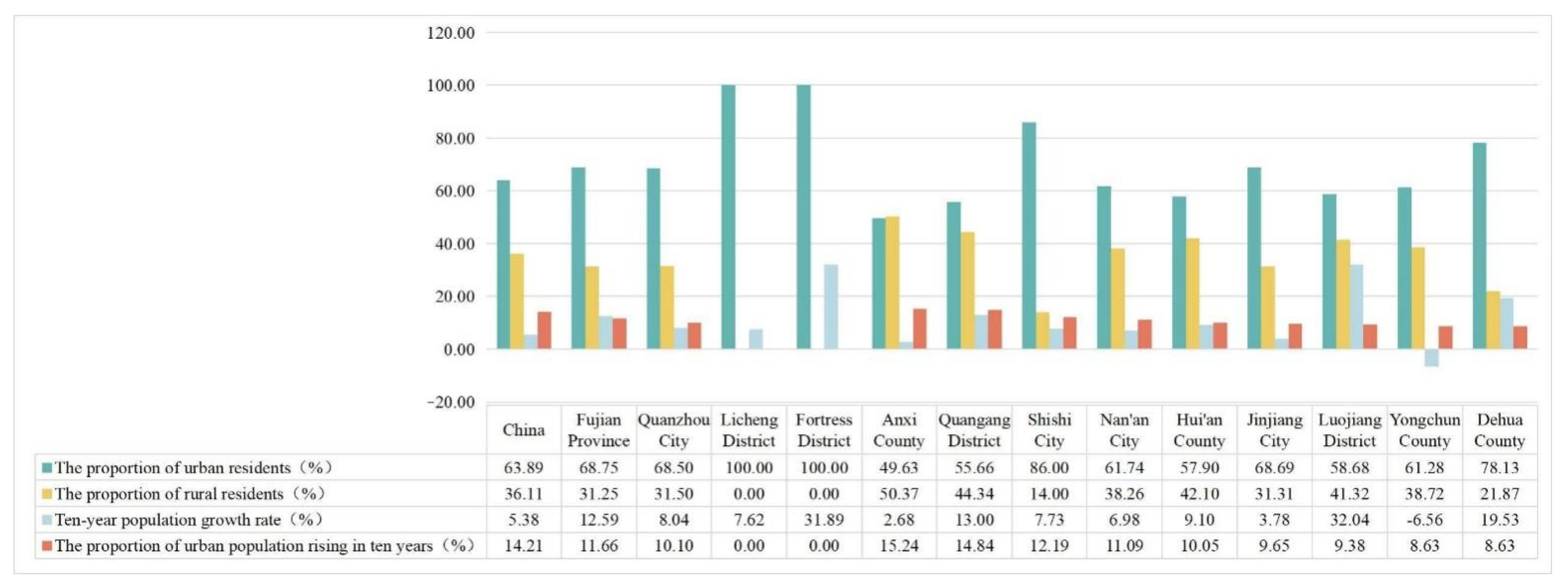



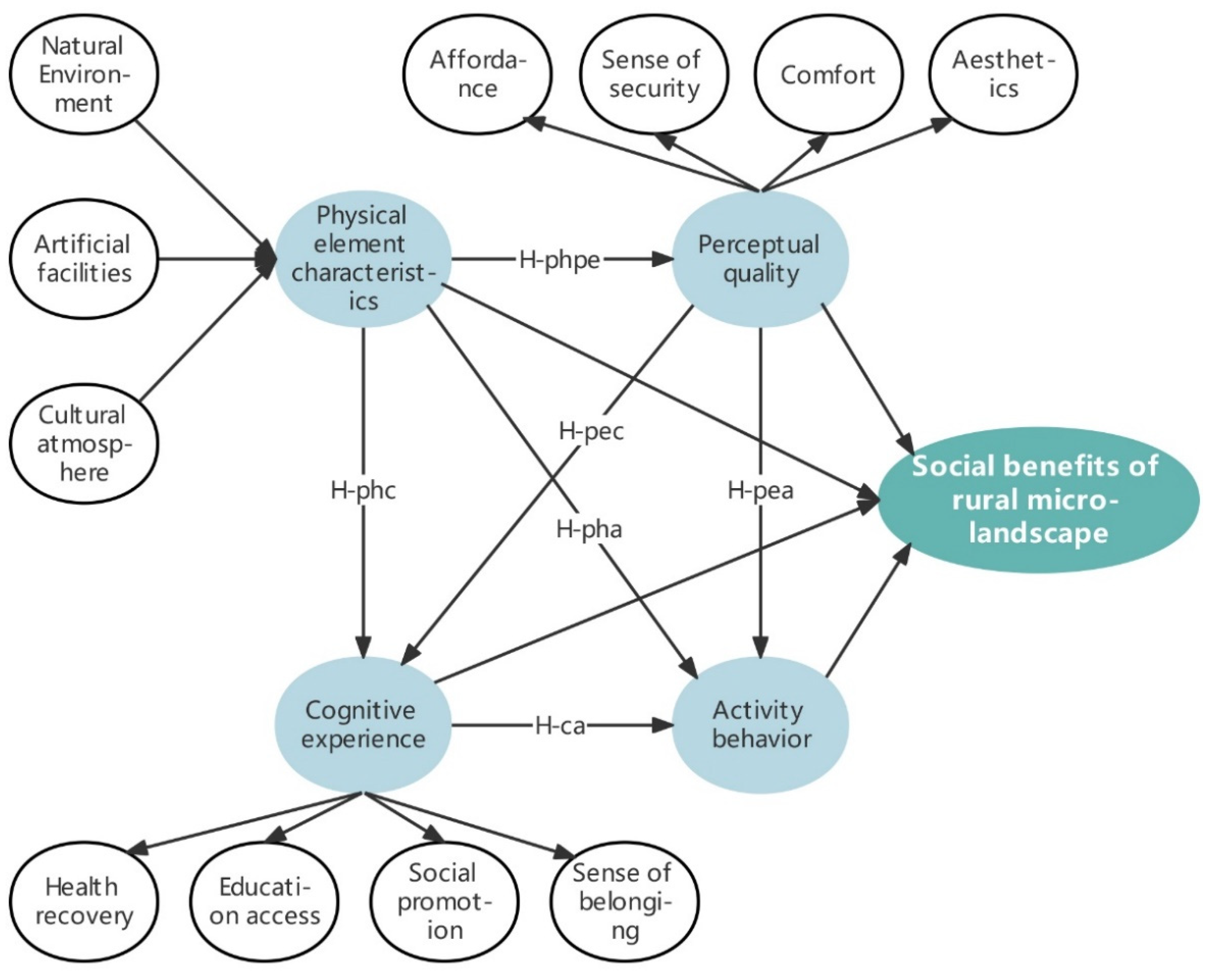
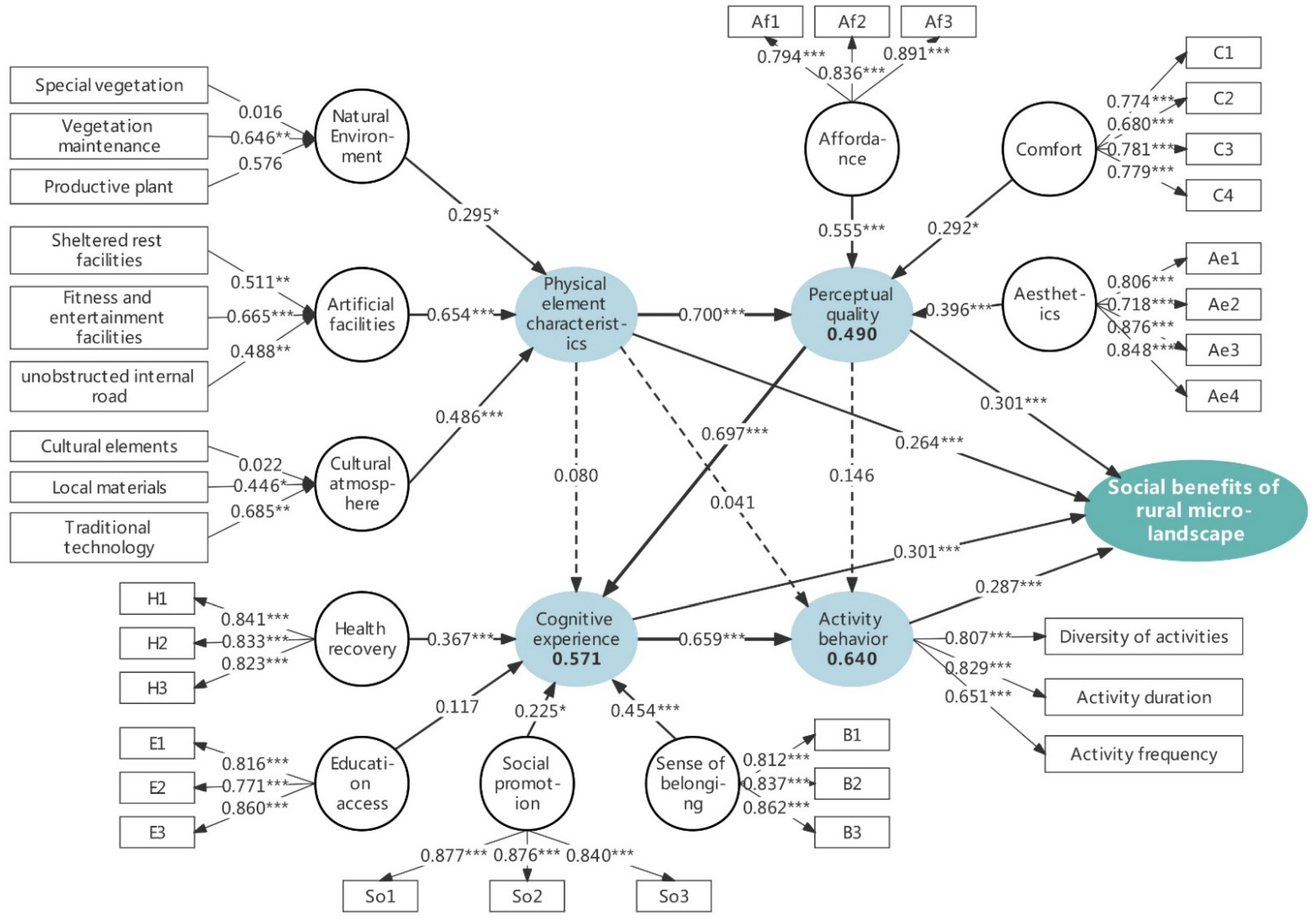
| Second-Order Latent Variables | First-Order Latent Variables | Observed Variables |
|---|---|---|
| Physical element characteristics | Natural environment | Tree canopy coverage |
| Plant species | ||
| Special vegetation (flower borders, shrub or tree forms, etc.) | ||
| Vegetation maintenance | ||
| Productive plants | ||
| Artificial facilities | Sheltered sitting facilities (pavilions, galleries, etc.) | |
| Fitness and recreational facilities | ||
| Unobstructed internal roads | ||
| Cultural atmosphere | Cultural elements (display of old objects, sculptures, pagodas, etc.) | |
| Local materials (bricks, stones, clay pots, etc.) | ||
| Traditional techniques (construction using bricks and stone, etc.) | ||
| Perceptual quality | Affordances | Af1—I have easy access to this micro-landscape. |
| Af2—I have fair and easy access to this micro-landscape. | ||
| Af3—I can perform the activities I need to in this micro-landscape. | ||
| Sense of security | Se1—The environment of this micro-landscape makes me want to stay away from it because I am afraid. | |
| Se2—Something disturbing may happen in this micro-landscape. | ||
| Se3—At night, I can enter this micro-landscape without hesitation. | ||
| Comfort | C1—The temperature of this micro-landscape is suitable. | |
| C2—The sound of this micro-landscape is pleasant. | ||
| C3—The smell of the micro-landscape is pleasant. | ||
| C4—The facilities of this micro-landscape are comfortable. | ||
| Aesthetics | Ae1—This micro-landscape is neat and clean. | |
| Ae2—This micro-landscape is interesting. | ||
| Ae3—This micro-landscape is beautiful. | ||
| Ae4—This micro-landscape is well-designed. | ||
| Cognitive experience | Health recovery | H1—My physical pain/discomfort is relieved by this micro-landscape. |
| H2—My anxiety/depression/stress is relieved by this micro-landscape. | ||
| H3—My energy level is increased by this micro-landscape. | ||
| Education access | E1—This micro-landscape helps me gain insight. | |
| E2—This micro-landscape provides me with the opportunity to try new things. | ||
| E3—This micro-landscape helps me understand the countryside. | ||
| Social promotion | So1—I have social interactions with others in this micro-landscape. | |
| So2—I can make friends in this micro-landscape. | ||
| So3—The people I meet in this micro-landscape are friendly. | ||
| Sense of belonging | B1—This micro-landscape feels very alien to me. | |
| B2—This micro-landscape allows me to fit in. | ||
| B3—If I leave for a while, I will miss this micro-landscape. | ||
| Activity behavior | Duration of activities | |
| Frequency of visits | ||
| Diversity of activities | ||
| Sample Micro-Landscape Project in San’ou Village | ||
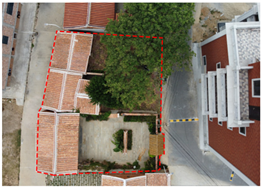 a-1 | 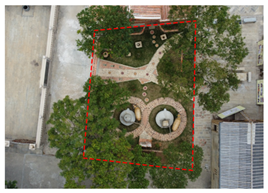 a-2 | 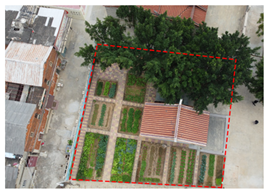 a-3 |
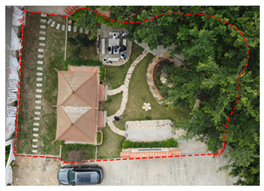 a-4 |  a-5 | 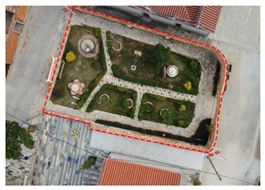 a-6 |
| Sample Micro-Landscape Project in Huwei Village | ||
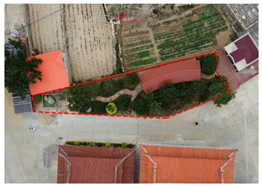 b-1 | 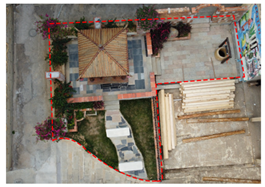 b-2 |  b-3 |
 b-4 | 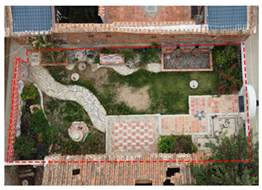 b-5 | 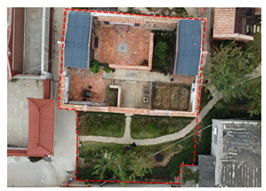 b-6 |
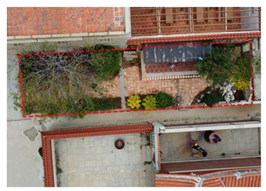 b-7 | 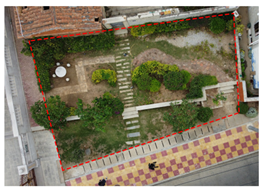 b-8 | 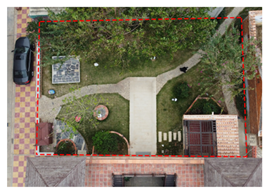 b-9 |
| Sample Micro-Landscape Project in Dongpu Village | ||
 c-1 |  c-2 |  c-3 |
| Second-Order Latent Variable | First-Order Latent Variables | Observed Variables | Weight | VIF | t-Value | p-Value | Out Loading | Retained |
|---|---|---|---|---|---|---|---|---|
| Physical element characteristics | Natural Environment | Tree canopy coverage | 0.015 | 2.086 | 0.056 | 0.956 | 0.431 | No |
| Plant species | −0.098 | 1.426 | 0.383 | 0.701 | −0.184 | No | ||
| Special vegetation | 0.031 | 1.970 | 0.086 | 0.931 | 0.584 | Yes | ||
| Vegetation maintenance | 0.635 | 1.310 | 2.509 | 0.012 | 0.825 | Yes | ||
| Productive plants | 0.551 | 2.696 | 1.381 | 0.167 | 0.788 | Yes | ||
| Artificial facilities | Fitness and recreational facilities | 0.665 | 1.058 | 5.002 | 0.000 | 0.798 | Yes | |
| Sheltered sitting facilities | 0.512 | 1.076 | 3.102 | 0.002 | 0.439 | Yes | ||
| Unobstructed internal roads | 0.488 | 1.117 | 2.785 | 0.005 | 0.501 | Yes | ||
| Cultural atmosphere | Cultural elements | 0.685 | 2.174 | 2.804 | 0.005 | 0.919 | Yes | |
| Local materials | 0.022 | 2.211 | 0.086 | 0.931 | 0.739 | Yes | ||
| Traditional techniques | 0.446 | 1.401 | 2.223 | 0.026 | 0.793 | Yes |
| Second-Order Latent Variables | First-Order Latent Variables | Observed Variables | Loading | CA | CR | AVE |
|---|---|---|---|---|---|---|
| Perceptual quality | Affordances | Af1 | 0.891 | 0.795 | 0.879 | 0.707 |
| Af2 | 0.836 | |||||
| Af3 | 0.794 | |||||
| Sense of security | Se1 | 0.837 | 0.789 | 0.875 | 0.700 | |
| Se2 | 0.838 | |||||
| Se3 | 0.834 | |||||
| Comfort | C1 | 0.774 | 0.759 | 0.841 | 0.570 | |
| C2 | 0.680 | |||||
| C3 | 0.781 | |||||
| C4 | 0.779 | |||||
| Aesthetics | Ae1 | 0.806 | 0.830 | 0.887 | 0.663 | |
| Ae2 | 0.718 | |||||
| Ae3 | 0.876 | |||||
| Ae4 | 0.848 | |||||
| Cognitive experience | Health recovery | H1 | 0.841 | 0.778 | 0.871 | 0.693 |
| H2 | 0.833 | |||||
| H3 | 0.823 | |||||
| Education access | E1 | 0.816 | 0.750 | 0.857 | 0.667 | |
| E2 | 0.771 | |||||
| E3 | 0.860 | |||||
| Social promotion | So1 | 0.877 | 0.831 | 0.899 | 0.747 | |
| So2 | 0.876 | |||||
| So3 | 0.840 | |||||
| Sense of belonging | B1 | 0.812 | 0.787 | 0.876 | 0.701 | |
| B2 | 0.837 | |||||
| B3 | 0.862 | |||||
| Activity behavior | Diversity of activities | 0.807 | 0.646 | 0.809 | 0.588 | |
| Duration of activities | 0.829 | |||||
| Frequency of visits | 0.651 | |||||
| First-Order Latent Variables | Affordances | Sense of Security | Comfort | Aesthetics | Health Recovery | Education Access | Social Promotion | Sense of Belonging | Activity Behavior |
|---|---|---|---|---|---|---|---|---|---|
| Affordances | 0.841 | ||||||||
| Sense of security | 0.296 | 0.836 | |||||||
| Comfort | 0.368 | 0.204 | 0.755 | ||||||
| Aesthetics | 0.407 | 0.371 | 0.656 | 0.814 | |||||
| Health recovery | 0.620 | 0.366 | 0.345 | 0.487 | 0.832 | ||||
| Education access | 0.417 | 0.137 | 0.318 | 0.489 | 0.374 | 0.817 | |||
| Social promotion | 0.643 | 0.222 | 0.399 | 0.345 | 0.619 | 0.412 | 0.864 | ||
| Sense of belonging | 0.621 | 0.339 | 0.490 | 0.556 | 0.684 | 0.587 | 0.725 | 0.837 | |
| Activity behavior | 0.547 | 0.345 | 0.583 | 0.488 | 0.683 | 0.427 | 0.670 | 0.739 | 0.767 |
| Second-Order Latent Variables | First-Order Latent Variables | Weight | VIF | t-Value | p-Value | Out Loading | Retained |
|---|---|---|---|---|---|---|---|
| Physical element characteristics | Natural environment | 0.293 | 1.072 | 2.232 | 0.026 | 0.480 | Yes |
| Artificial facilities | 0.668 | 1.051 | 6.201 | 0.000 | 0.799 | Yes | |
| Cultural atmosphere | 0.472 | 1.114 | 3.445 | 0.001 | 0.691 | Yes | |
| Perceptual quality | Affordances | 0.542 | 1.267 | 7.130 | 0.000 | 0.821 | Yes |
| Sense of security | 0.051 | 1.203 | 0.497 | 0.620 | 0.411 | No | |
| Comfort | 0.311 | 1.805 | 3.039 | 0.002 | 0.762 | Yes | |
| Aesthetics | 0.367 | 2.015 | 3.241 | 0.001 | 0.810 | Yes | |
| Cognitive experience | Health recovery | 0.356 | 2.005 | 3.856 | 0.000 | 0.857 | Yes |
| Education access | 0.114 | 1.529 | 1.304 | 0.192 | 0.613 | Yes | |
| Social promotion | 0.228 | 2.241 | 2.234 | 0.026 | 0.831 | Yes | |
| Sense of belonging | 0.463 | 3.210 | 3.975 | 0.000 | 0.939 | Yes |
| Second-Order Latent Variables | First-Order Latent Variables | Weight | t-Value | p-Value |
|---|---|---|---|---|
| Physical element characteristics | Natural environment | 0.295 | 2.181 | 0.029 |
| Artificial facilities | 0.654 | 6.288 | 0.000 | |
| Cultural atmosphere | 0.486 | 3.783 | 0.000 | |
| Perceptual quality | Affordances | 0.555 | 8.194 | 0.000 |
| Comfort | 0.292 | 3.017 | 0.003 | |
| Aesthetics | 0.396 | 3.674 | 0.000 | |
| Cognitive experience | Health recovery | 0.367 | 3.898 | 0.000 |
| Education access | 0.117 | 1.382 | 0.167 | |
| Social promotion | 0.225 | 2.313 | 0.021 | |
| Sense of belonging | 0.454 | 4.002 | 0.000 |
| Third-Order Latent Variable | Second-Order Latent Variables | Weight | VIF | t-Value | p-Value |
|---|---|---|---|---|---|
| Social benefits of rural micro-landscapes | Physical element characteristics | 0.264 | 1.976 | 35.231 | 0.000 |
| Perceptual quality | 0.301 | 3.124 | 37.870 | 0.000 | |
| Cognitive experience | 0.301 | 3.479 | 36.190 | 0.000 | |
| Activity behavior | 0.287 | 2.734 | 40.379 | 0.000 |
| Path Relationship | Path Factor | t-Value | p-Value | f2 | Hypothesis Result | |
|---|---|---|---|---|---|---|
| H-phpe | Physical element characteristics → Perceptual quality | 0.700 | 13.177 | 0.000 | 0.960 | Supported |
| H-phc | Physical element characteristics → Cognitive experience | 0.080 | 0.919 | 0.358 | 0.008 | Not supported |
| H-pha | Physical element characteristics → Activity behavior | 0.041 | 0.493 | 0.622 | 0.002 | Not supported |
| H-pec | Perceptual quality → Cognitive experience | 0.697 | 8.479 | 0.000 | 0.578 | Supported |
| H-pea | Perceptual quality → Activity behavior | 0.146 | 1.313 | 0.189 | 0.019 | Not supported |
| H-ca | Cognitive experience → Activity behavior | 0.659 | 7.851 | 0.000 | 0.517 | Supported |
| Second-Order Conception | R2 | SSO | SSE | Q2 (=1-SSE/SSO) |
|---|---|---|---|---|
| Physical element characteristics | - | 306.000 | 306.000 | - |
| Perceptual quality | 0.490 | 306.000 | 209.344 | 0.316 |
| Cognitive experience | 0.571 | 408.000 | 254.300 | 0.377 |
| Activity behavior | 0.640 | 306.000 | 197.718 | 0.354 |
| Path Relationship | Path Coefficient | t-Value | p-Value |
|---|---|---|---|
| Physical element characteristics → Social benefits | 0.793 | 23.259 | 0.000 |
| Perceptual quality → Social benefits | 0.683 | 14.907 | 0.000 |
| Cognitive experience → Social benefits | 0.489 | 17.223 | 0.000 |
| Activity behavior → Social benefits | 0.286 | 10.481 | 0.000 |
| Path Relationships between Second-Order Latent Variables | Path Relationships between First-Order Latent Variables | Path Coefficient |
|---|---|---|
| Physical element characteristics → Perceptual quality 0.700 *** | Natural environment → Affordances | 0.205 ns |
| Natural environment → Comfort | 0.227 * | |
| Natural environment → Aesthetics | 0.365 * | |
| Artificial facilities → Affordances | 0.228 * | |
| Artificial facilities → Comfort | 0.464 *** | |
| Artificial facilities → Aesthetics | 0.267 *** | |
| Cultural atmosphere → Affordances | 0.297 ** | |
| Cultural atmosphere → Comfort | 0.132 ns | |
| Cultural atmosphere → Aesthetics | 0.403 *** | |
| Physical element characteristics → Cognitive experience 0.080 ns | Natural environment → Health recovery | 0.179 ns |
| Natural environment → Education access | 0.078 ns | |
| Natural environment → Social promotion | 0.157 ns | |
| Natural environment → Sense of belonging | 0.130 ns | |
| Artificial facilities → Health recovery | 0.273 ** | |
| Artificial facilities → Education access | 0.139 ns | |
| Artificial facilities → Social promotion | 0.342 *** | |
| Artificial facilities → Sense of belonging | 0.329 *** | |
| Cultural atmosphere → Health recovery | 0.219 * | |
| Cultural atmosphere → Education access | 0.459 *** | |
| Cultural atmosphere → Social promotion | 0.171 * | |
| Cultural atmosphere → Sense of belonging | 0.305 *** | |
| Physical element characteristics → Activity behavior 0.041 ns | Natural environment → Activity behavior | −0.009 ns |
| Artificial facilities → Activity behavior | 0.515 *** | |
| Cultural atmosphere → Activity behavior | 0.181 * | |
| Perceptual quality → Cognitive experience 0.697 *** | Affordances → Health recovery | 0.516 *** |
| Affordances → Education access | 0.206 * | |
| Affordances → Social promotion | 0.547 *** | |
| Affordances → Sense of belonging | 0.444 *** | |
| Comfort → Health recovery | −0.106 ns | |
| Comfort → Education access | −0.018 ns | |
| Comfort → Social promotion | 0.131 ns | |
| Comfort → Sense of belonging | 0.095 ns | |
| Aesthetics → Health recovery | 0.354 * | |
| Aesthetics → Education access | 0.278 ns | |
| Aesthetics → Social promotion | −0.053 ns | |
| Aesthetics → Sense of belonging | 0.289 * | |
| Perceptual quality → Activity behavior 0.146 ns | Affordances → Activity behavior | 0.371 * |
| Comfort → Activity behavior | 0.272 ** | |
| Aesthetics → Activity behavior | 0.188 ns | |
| Cognitive experience → Activity behavior 0.659 *** | Health recovery → Activity behavior | 0.304 ** |
| Education access → Activity behavior | 0.030 ns | |
| Social promotion → Activity behavior | 0.173 ns | |
| Sense of belonging → Activity behavior | 0.251 * |
Publisher’s Note: MDPI stays neutral with regard to jurisdictional claims in published maps and institutional affiliations. |
© 2022 by the authors. Licensee MDPI, Basel, Switzerland. This article is an open access article distributed under the terms and conditions of the Creative Commons Attribution (CC BY) license (https://creativecommons.org/licenses/by/4.0/).
Share and Cite
Shen, L.; Li, Y.; Lan, S.; Yao, M. Social Benefits Evaluation of Rural Micro-Landscapes in Southeastern Coastal Towns of China—The Case of Jinjiang, Fujian. Sustainability 2022, 14, 8036. https://doi.org/10.3390/su14138036
Shen L, Li Y, Lan S, Yao M. Social Benefits Evaluation of Rural Micro-Landscapes in Southeastern Coastal Towns of China—The Case of Jinjiang, Fujian. Sustainability. 2022; 14(13):8036. https://doi.org/10.3390/su14138036
Chicago/Turabian StyleShen, Lan, Yueying Li, Siren Lan, and Minfeng Yao. 2022. "Social Benefits Evaluation of Rural Micro-Landscapes in Southeastern Coastal Towns of China—The Case of Jinjiang, Fujian" Sustainability 14, no. 13: 8036. https://doi.org/10.3390/su14138036






